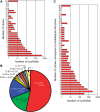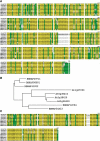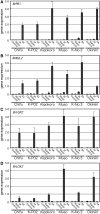Development of full-length cDNAs from Chinese cabbage (Brassica rapa Subsp. pekinensis) and identification of marker genes for defence response
- PMID: 21745830
- PMCID: PMC3158467
- DOI: 10.1093/dnares/dsr018
Development of full-length cDNAs from Chinese cabbage (Brassica rapa Subsp. pekinensis) and identification of marker genes for defence response
Abstract
Arabidopsis belongs to the Brassicaceae family and plays an important role as a model plant for which researchers have developed fine-tuned genome resources. Genome sequencing projects have been initiated for other members of the Brassicaceae family. Among these projects, research on Chinese cabbage (Brassica rapa subsp. pekinensis) started early because of strong interest in this species. Here, we report the development of a library of Chinese cabbage full-length cDNA clones, the RIKEN BRC B. rapa full-length cDNA (BBRAF) resource, to accelerate research on Brassica species. We sequenced 10 000 BBRAF clones and confirmed 5476 independent clones. Most of these cDNAs showed high homology to Arabidopsis genes, but we also obtained more than 200 cDNA clones that lacked any sequence homology to Arabidopsis genes. We also successfully identified several possible candidate marker genes for plant defence responses from our analysis of the expression of the Brassica counterparts of Arabidopsis marker genes in response to salicylic acid and jasmonic acid. We compared gene expression of these markers in several Chinese cabbage cultivars. Our BBRAF cDNA resource will be publicly available from the RIKEN Bioresource Center and will help researchers to transfer Arabidopsis-related knowledge to Brassica crops.
Figures






Similar articles
-
Characterization and expression profiling of MYB transcription factors against stresses and during male organ development in Chinese cabbage (Brassica rapa ssp. pekinensis).Plant Physiol Biochem. 2016 Jul;104:200-15. doi: 10.1016/j.plaphy.2016.03.021. Epub 2016 Mar 18. Plant Physiol Biochem. 2016. PMID: 27038155
-
Genome-wide analysis of the AP2/ERF transcription factor superfamily in Chinese cabbage (Brassica rapa ssp. pekinensis).BMC Genomics. 2013 Aug 23;14:573. doi: 10.1186/1471-2164-14-573. BMC Genomics. 2013. PMID: 23972083 Free PMC article.
-
Genome-Wide Identification, Expression Analysis and Functional Study of DELLA Genes in Chinese Cabbage (Brassica rapa L. ssp. pekinensis).Front Biosci (Landmark Ed). 2024 May 21;29(5):198. doi: 10.31083/j.fbl2905198. Front Biosci (Landmark Ed). 2024. PMID: 38812324
-
Gene co-expression network analysis reveals key pathways and hub genes in Chinese cabbage (Brassica rapa L.) during vernalization.BMC Genomics. 2021 Apr 6;22(1):236. doi: 10.1186/s12864-021-07510-8. BMC Genomics. 2021. PMID: 33823810 Free PMC article. Review.
-
Exploiting Brassica rapa L. subsp. pekinensis Genome Research.Plants (Basel). 2024 Oct 9;13(19):2823. doi: 10.3390/plants13192823. Plants (Basel). 2024. PMID: 39409693 Free PMC article. Review.
Cited by
-
Identification and characterization of Crr1a, a gene for resistance to clubroot disease (Plasmodiophora brassicae Woronin) in Brassica rapa L.PLoS One. 2013;8(1):e54745. doi: 10.1371/journal.pone.0054745. Epub 2013 Jan 30. PLoS One. 2013. PMID: 23382954 Free PMC article.
-
Defence signalling marker gene responses to hormonal elicitation differ between roots and shoots.AoB Plants. 2018 May 16;10(3):ply031. doi: 10.1093/aobpla/ply031. eCollection 2018 Jun. AoB Plants. 2018. PMID: 29977487 Free PMC article.
-
The transcriptional response to salicylic acid plays a role in Fusarium yellows resistance in Brassica rapa L.Plant Cell Rep. 2021 Apr;40(4):605-619. doi: 10.1007/s00299-020-02658-1. Epub 2021 Jan 18. Plant Cell Rep. 2021. PMID: 33459838
-
BrLAS, a GRAS Transcription Factor From Brassica rapa, Is Involved in Drought Stress Tolerance in Transgenic Arabidopsis.Front Plant Sci. 2018 Dec 6;9:1792. doi: 10.3389/fpls.2018.01792. eCollection 2018. Front Plant Sci. 2018. PMID: 30574156 Free PMC article.
-
Identification of candidate genes for Fusarium yellows resistance in Chinese cabbage by differential expression analysis.Plant Mol Biol. 2014 Jun;85(3):247-57. doi: 10.1007/s11103-014-0182-0. Epub 2014 Mar 26. Plant Mol Biol. 2014. PMID: 24668026
References
Publication types
MeSH terms
Substances
LinkOut - more resources
Full Text Sources

